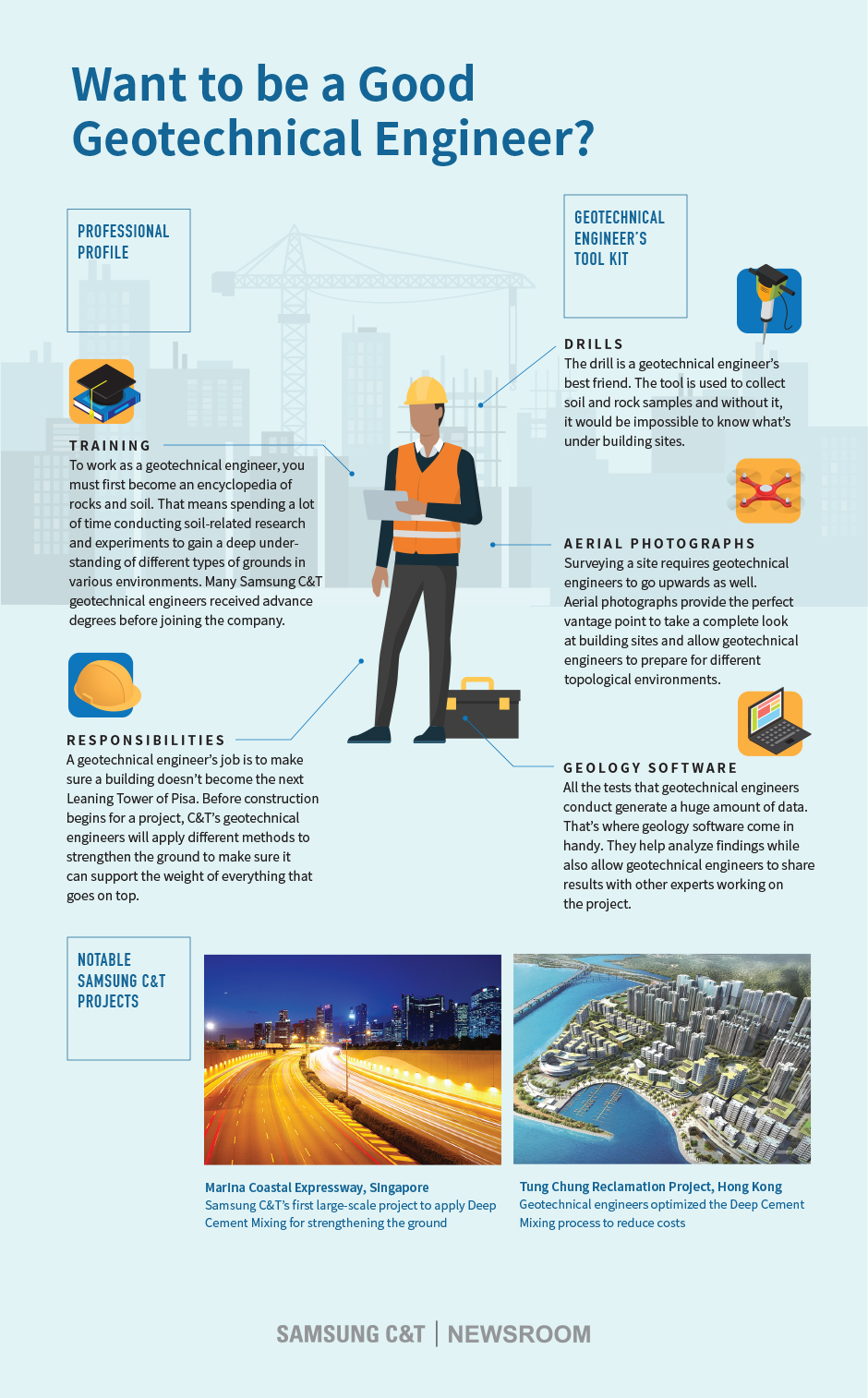Everything about Geotheta
Everything about Geotheta
Blog Article
Geotheta Things To Know Before You Get This
Table of ContentsThe Best Strategy To Use For GeothetaWhat Does Geotheta Do?The Single Strategy To Use For GeothetaThe Facts About Geotheta Revealed7 Simple Techniques For Geotheta

They carry out site investigations, collect examples, do laboratory examinations, and analyze data to review the suitability of the ground for building tasks - Geo Tech Engineering. Based upon their findings, geotechnical engineers provide recommendations for structure style, slope stability, retaining structures, and mitigation of geotechnical hazards. They team up with other experts, such as engineers, structural engineers, and building teams, to ensure that geotechnical factors to consider are integrated right into the total job design and implementation
By evaluating the habits and buildings of dirt and rock, they can recognize prospective geotechnical dangers such as landslides, soil settlement, or incline instability. Their know-how aids avoid failures or mishaps that can endanger lives and residential or commercial property. Right here are some comprehensive responsibilities and obligations of a geotechnical designer: Website Investigation: Geotechnical designers conduct site examinations to gather information on subsurface conditions.
They translate the data to recognize the residential or commercial properties and behavior of the dirt and rock, including their stamina, leaks in the structure, compaction features, and groundwater conditions. Geotechnical Analysis and Layout: Geotechnical engineers assess the information accumulated during site examinations to analyze the security and viability of the website for construction projects. They carry out geotechnical calculations and modeling to examine aspects such as birthing ability, settlement, incline security, lateral earth pressures, and groundwater circulation.
How Geotheta can Save You Time, Stress, and Money.
Structure Style: Geotechnical engineers play a vital role in making foundations that can safely sustain the desired framework. They assess the soil problems and tons needs to identify the appropriate foundation type, such as superficial foundations (e.g., grounds), deep structures (e.g (https://realistic-swam-lvtf1k.mystrikingly.com/blog/unlocking-the-secrets-of-geotechnical-engineers-the-geotheta-advantage)., heaps), or specialized methods like soil enhancement. They think about elements such as negotiation restrictions, bearing capacity, and soil-structure communication to develop ideal structure styles
They review construction strategies, monitor site activities, and carry out area evaluations to verify that the layout recommendations are complied with. If unforeseen geotechnical issues emerge, they examine the situation and provide suggestions for remediation or adjustments to the design. Threat Evaluation and Reduction: Geotechnical designers assess geotechnical dangers and dangers related to the job website, such as landslides, liquefaction, or soil disintegration.

Collaboration and Interaction: Geotechnical engineers work very closely with various other specialists entailed in a task, such as designers, architectural engineers, and building and construction groups. Effective interaction and partnership are necessary to incorporate geotechnical considerations into the total project layout and construction process. Geotechnical designers give technical knowledge, answer inquiries, and guarantee that geotechnical needs are fulfilled.
Things about Geotheta
Below are some kinds of geotechnical designers: Structure Engineer: Structure engineers focus on creating and evaluating foundations for structures. They evaluate the dirt conditions, load requirements, and site characteristics to determine the most proper structure kind and design, such as superficial foundations, deep foundations, or specialized techniques like pile foundations.
They examine the aspects influencing slope stability, such as soil buildings, groundwater problems, and slope geometry, and create strategies to protect against slope failings and minimize risks. Earthquake Engineer: Quake designers focus on assessing and creating frameworks to endure seismic forces. They assess the seismic risk of a website, evaluate dirt liquefaction potential, and establish seismic style standards to guarantee the safety and strength of frameworks throughout quakes.
They do area testing, gather samples, and evaluate the collected information to identify the soil residential or commercial properties, geologic formations, and groundwater problems at a site. Geotechnical Instrumentation Engineer: Geotechnical instrumentation designers concentrate on tracking and measuring the actions of dirt, rock, and structures. They set up and maintain instrumentation systems that check factors such as soil settlement, groundwater degrees, slope activities, and architectural displacements to evaluate efficiency and supply very early cautions of prospective problems.
Little Known Facts About Geotheta.
They carry out tests such as triaxial examinations, consolidation tests, direct shear tests, and permeability examinations to collect data for geotechnical evaluation and style. Geosynthetics Engineer: Geosynthetics designers specialize in the style and application of geosynthetic products, such as geotextiles, geogrids, and geomembranes. They make use of these products to improve soil security, reinforce slopes, give drainage remedies, and control erosion.
They have a tendency to be Geo Tech Engineer investigatory individuals, which implies they're intellectual, reflective, and curious. They are curious, systematic, rational, analytical, and logical. Some of them are likewise social, meaning they're kind, generous, cooperative, individual, caring, helpful, empathetic, tactful, and pleasant - Geo Tech Engineer.
In the workplace atmosphere, geotechnical engineers use specialized software devices to carry out estimations, develop layouts, and analyze data. They prepare records, evaluation job requirements, connect with clients and group members, and coordinate task tasks. The office setup offers a helpful atmosphere for research study, evaluation, and partnership with various other experts associated with the job.
Some Known Details About Geotheta
They frequently check out project sites to perform site investigations, evaluate geotechnical conditions, and collect data for evaluation. These check outs entail traveling to different areas, in some cases in remote or tough terrains. Geotechnical designers may do soil tasting, conduct examinations, and monitor building tasks to make sure that the geotechnical aspects of the job are being implemented properly.
Geotechnical engineers also work in specialized geotechnical laboratories. Geotechnical research laboratory engineers function extensively in these atmospheres, taking care of testing tools, running instruments, and videotaping information.
Report this page